Armed Robots: US Lags Rhetoric, Russia
Posted on
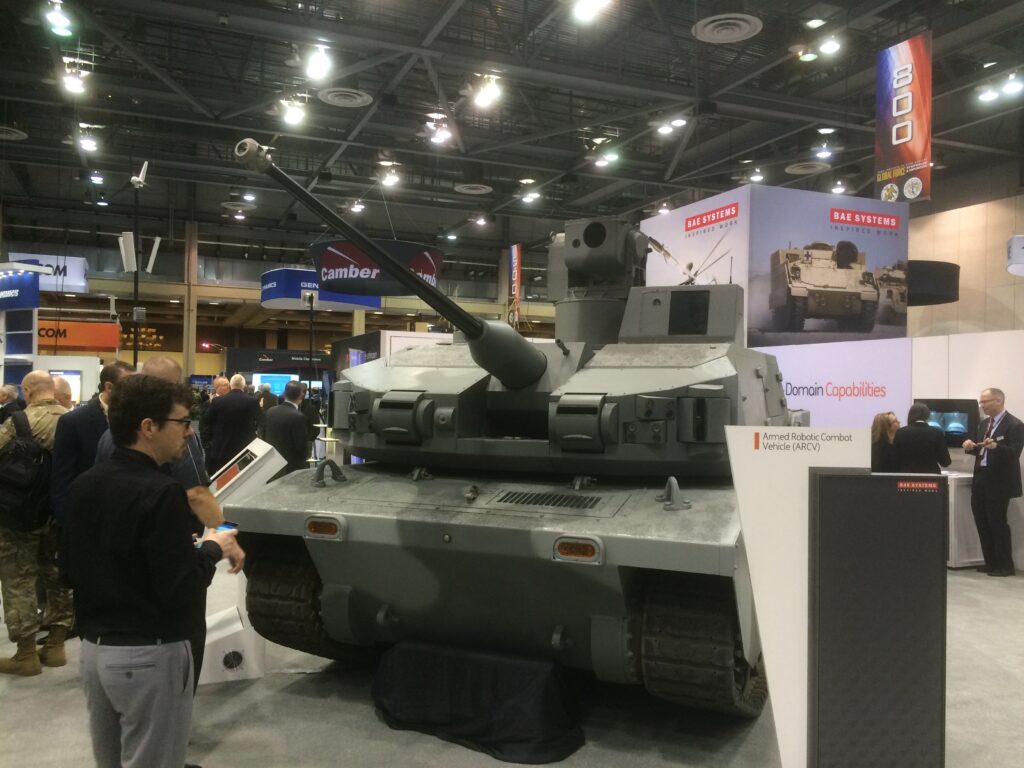
BAE’s Armed Robotic Combat Vehicle (ARCV) is the only armed unmanned system of its size to be developed in the US.
AUSA: American military leaders talk how artificial intelligence will change the face of war, but the unmanned ground vehicles (UGVs) actually in development are much more modest and less lethal. They’re mostly small, mostly unarmed, and fall short not only of Pentagon visions of future warfare, but of the tank-like machines the Russians are experimenting with today.
While the US Army spent $521 million on robotics in 2017, 79 percent went to aerial drones. Only $20.6 million went to buy unmanned ground vehicles in 2017, almost all for UGVs to clear mines and roadside bombs, while $91.4 million on R&D — and 40 percent of that was for mine-clearance as well.

Sam Bendett
So, walking the exhibit halls last week at the Association of the US Army annual conference, CNA analyst Sam Bendett did see plenty of unmanned ground vehicles. But most were lightweight, unarmed, and remote-controlled: bomb squad bots, scout bots, cargo haulers, and other “supporting elements,” he told me, not true fighting robots.
“There were some armed UGVs, but they were light, at most several hundred pounds,” Bendett said. “What was notably absent was any large-sized combat UGV.” (The only partial exception was Ukrainian).
“It would have been interesting to see what larger concepts are being tested,” Bendett said. At a previous AUSA event in Huntsville, Ala, the displays did include a remote-controlled mini-tank, BAE Systems’ Armed Robotic Combat Vehicle, but that exception proves the rule. ARCV was originally developed for the Future Combat Systems program (under the name Black Knight) and has been orphaned since FCS was cancelled in 2009. I know of no one in the US who’s built anything so ambitious since.
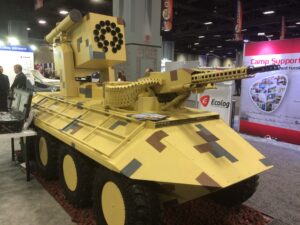
Ukrainian Phantom/Fantom armed unmanned ground vehicle.
By contrast, “the Russians are pursuing a wide range of systems, even building and developing tank-sized devices,” Bendett said. “A lot of these heavier machines are heavily armed, and Russians often display these prototypes at exhibitions.”
“Russia is building a whole menagerie of armed ground robots all the way up to the size of armored personnel carriers,” agreed Paul Scharre, director of technology and security at the Center for a New American Security and author of a forthcoming book on robotics, Army of None. Examples include the 11-ton Uran-9 and the 16-ton Vikhr (Whirlwind), derived from the standard BMP-3 troop carrier. There’s even talk of an unmanned version of the new T-14 Armata tank, Scharre told me, although the basic manned version is just entering production.

Paul Scharre
Some of these designs are more publicity stunts than practical war machines. For example, the Russians tout a man-shaped machine named F.E.D.OR. that was able to fire a pistol in each hand. The more realistic Russian UGVs are conventional armored vehicles refitted for remote control, not truly autonomous robots. That means they require constant human supervision over an uninterrupted communications link, much like the Predator drone. Such “teleoperated” systems require a human crew, just not inside the vehicle. They can be paralyzed, crashed, or even hijacked if someone interferes with the control signal, making their value dubious against a high-tech enemy.
What about artificial intelligence? The Russians have developed an autonomous gun turret that can be attached to a wide variety of vehicles, Bendett said, “but it has trouble distinguishing between friend and foe in autonomous operational mode.” No wonder, then, that Russian leaders seem to have some reservations about truly autonomous armed robots, just like American policymakers. Instead, Bendett told me, Russian research currently seems focused on developing sufficient artificial intelligence for an unmanned ground vehicle to get itself out of trouble if it loses communications with its human overseers — not to press the attack.
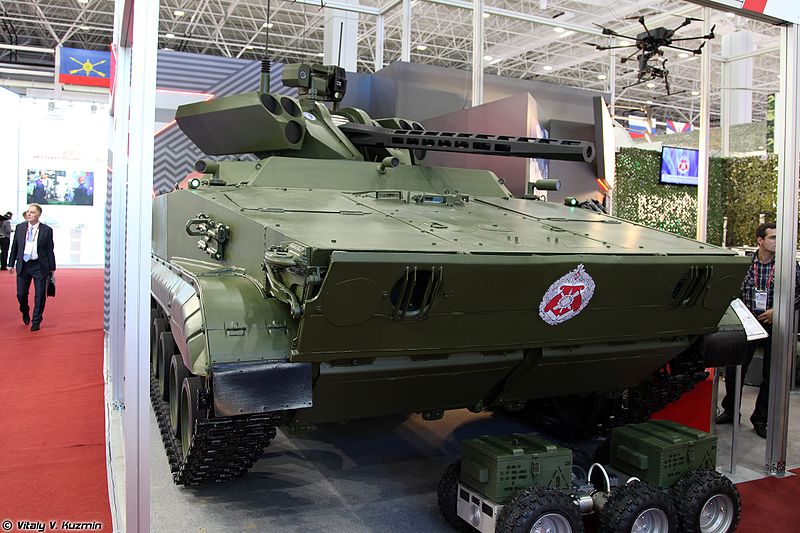
Russian Vikhr (Whirlwind) unmanned ground vehicle, a modified BMP-3 infantry fighting vehicle.
The Concepts Gap
So who’s really ahead? “In a technical sense of what their vehicles can actually do autonomously as opposed to teleoperated, I don’t know if the Russians are ahead of the United states or anyone else,” Scharre told me, “but conceptually, Russia is clearly in a different place in the United States.”
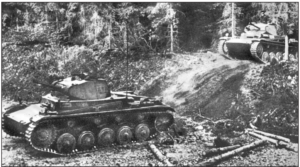
German Panzers cross the Ardennes to take French forces by surprise, 1940.
In war, concepts matter at least as much as technology. Britain and France had more tanks in 1940 than Nazi Germany, and the Allies’ machines were generally better armed and armored. But the Germans used theirs better – in what became known as blitzkrieg – because they’d thought about it longer and harder, developing new tactics and sticking radios on planes, tanks and trucks to coordinate fast, far-ranging maneuvers.
With robotics today, Scharre said, “we’re in a place similar to the tank in 1919. We know tanks are going to be important in warfare, but we don’t know how. (Likewise), we don’t know what the most game changing aspects of robotics are.”
“There’s obviously some hesitation in DoD (the Department of Defense) as a whole in thinking about autonomous armed robotic systems… but the US Army in particular is very hesitant to arm ground robots, for reasons I don’t entirely understand,” Scharre said. “Even at the furthest horizon they still envision robotics systems complementing human units… Russian generals have talked about fully robotic units that would operate independently.”

Russian Uran-9 armed unmanned ground vehicle
Why is the US Army so cautious? Part of the problem is ethics. While the Russian military flattened Grozny and aids Assad’s barrel bombers in Syria, a generation of US soldiers has grown up fighting under strict rules of engagement. Robots can’t navigate these ethical and tactical complexities as well as humans, especially since artificial intelligence is still prone to stunning stupidity in situations it wasn’t programmed for.
Even allowing for these deep cultural differences, however, Scharre fears part of the US Army’s problem is a simple failure of imagination. “What really matters is whether a country is serious about pursuing that technology and experimenting with it and incorporating it into its force,” he said, and he’s not seeing that.
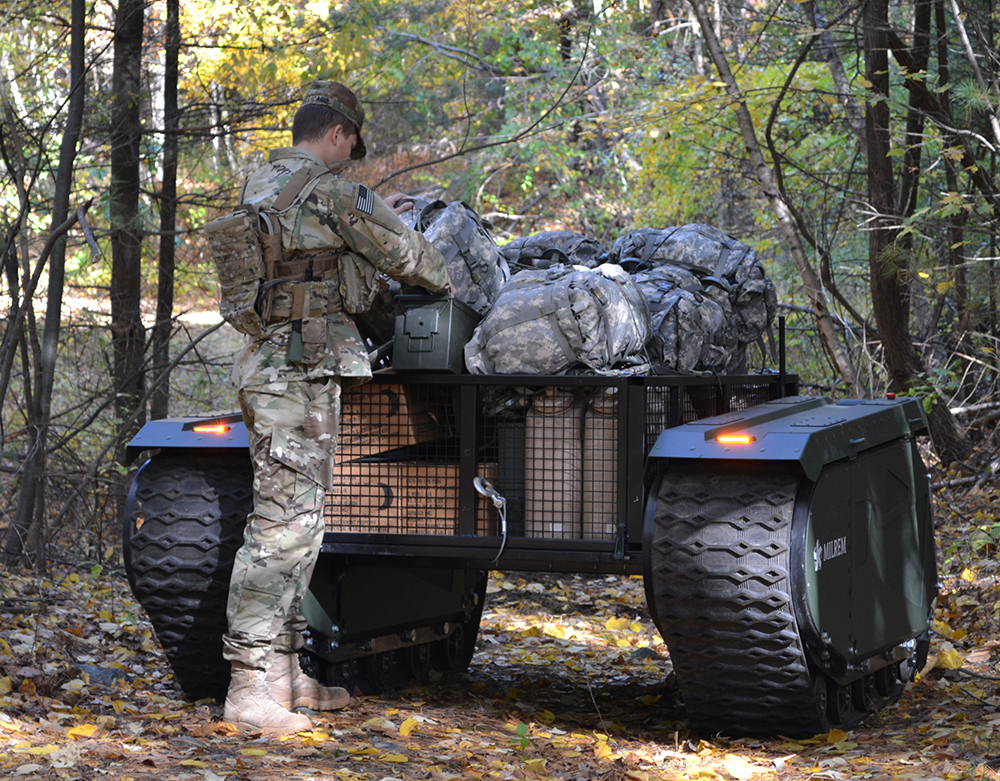
Qinetiq Titan robot (unmanned ground vehicle)
Pack Mules and Robot Trucks
So what is the US Army actually doing? Attention at AUSA focused on the competition for the small and unarmed S-MET. Pronounced “ess-mett,” the Squad Maneuver Equipment Transport is essentially a robotic pack mule to accompany foot infantry and carry rucksacks, water, spare ammo, and other bulky supplies that slow soldiers down today. Contenders on display at AUSA ranged from Polaris’s self-driving dune buggy to Qinetiq’s tracked Titan the size of a golf cart. This program’s moving fairly rapidly: an official “directed requirement” last April, eight competitors tested over slopes and swamp this fall, with four winners heading to infantry brigades for soldier testing and feedback next year.

Brig. Gen. David Komar
The whole point of S-MET is to ease infantry operations, not revolutionize them, Brig. Gen. David Komar told me. (He’s chief concept developer at the Army Capabilities Integration Center). “We don’t want the maneuver forces to have to adapt what they do based on what the S-MET can do,” he said. Much of the necessary technology exists in the civilian sector, but hardly all. Commercial robotics rarely worry about engine noise giving away an ambush or traversing tough terrain.
In experiments so far, the Army’s experience has been mixed. “Smaller machines require much more care and attention from the soldiers” than tank-sized ones, Bendett said. Never mind enemy action, he said: “If it flips over on rough terrain, it can’t get back up.” Small robots are notorious for getting hung up on obstacles humans can walk right over — rocks, mud, steep slopes, fallen logs — and once the bot is stuck, the squad has to either write off the expensive equipment and walk away, or take time and energy away from the mission to recover it. (“This is an issue that all countries developing various UGV concepts have to contend with,” he noted.)
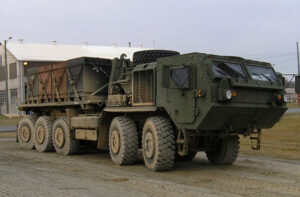
M1075A1 Armored Palletized Load System (PLS), a variant of the Heavy Expanded Mobility Tactical Truck (HEMTT)
The Army’s largest unmanned ground vehicle is also unarmed. Leader-Follower Automated Ground Resupply, launched this year, will put self-driving technology on up 150 existing HEMTT-PLS heavy trucks. The concept is that only the lead vehicle in each supply convoy would be manned, and the rest would self-drive along behind it (hence the name). There’ll be a demonstration in Michigan this month, Komar told me.
Leader-follower is valuable in itself, saving manpower and reducing personnel at risk in vulnerable supply convoys. But, said Komar, it also lays the foundation for more ambitious robotics: “It’s going to help us mature technologies to help us with the much more difficult problems of traveling cross country in difficult terrain in a tactical formation.”
What about armed unmanned ground vehicles, I asked. Komar paused thoughtfully and then replied, “we are looking at that capability.” But he didn’t discuss any specific systems in development or even concepts for systems.
“Whatever capability we bring to the field (must fit) within our concept and then eventually in our doctrine,” Komar emphasized, “(and) DoD policy for lethal systems is we always have a human in the loop.”
Subscribe to our newsletter
Promotions, new products and sales. Directly to your inbox.
